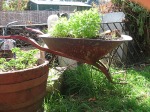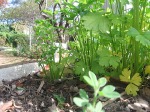The first post by Grace Miller (12)
Now, as you know or at least I think you know that recycling is a big part of our lives if we start now we will make our world a better place to live in.
You can recycle lots of things like cans, bottles, paper and aluminium, but there are some things that you can’t recycle like glade wrap, plastic, leftover food.
We can also recycle clothes, shoes, blankets, toys, books. You may be thinking how on earth do you recycle these things, well it is very easy gather up your clothes, shoes and other things you don’t want and then either take them to charity shop(hand in hand) or hand them down to friends and Family.
Guess what! You can recycle food as well but not just any food if you recycle things that had to be eaten straight away after being bought of open it would go mouldy. But don’t just have to recycle food you can also give food away to people who don’t have food like baked beans, tin corn, baby food, tin fruit and basically anything that is in a tin, it will stay fresh.
Also if you are into gardening another way to recycle your food is to make a compost bin or pile. Get a few hundred worms, a bucket or make a pile of fruit, vege’s, anything that not cooked foods, dirt and there you go a worm house, just make sure that no pets or animals eat it. Then once the worms have fertilised the food you can put it on your garden to feed your plants.
You can also recycle water. Water can be recycled out of water bottles, dog baths, cups and out of the washing machine. The water from the washing machine goes through a pipe and down in to your garden, but don’t put the washing machine water on the vegetables or fruit gardens because the soap power is in the water.
When you go shopping do you put your food in plastic bags or cloth shopping bags? Well instead of using plastic bags try to use the cloth bags. If you throw plastic bags into the recycling bin it takes 400 hundred years for a plastic bag to disintegrate so next time you go shopping please try and use a cloth bags it is just going to help the world a little more.
We can also reusethings in your house hold like milk bottles, fruit cups, ice cream boxes, lids and containers.
The containers can be used to put paint in, sandwiches for lunches, beads, craft things and even plants. We can also recycle and reuse clothes by wearing them more and that will reduce the water supply in your house.
So before you recycle, reduce the things that you buy and throw away like I said before put the food in your garden, make use out of what you do every day. Then if anything is left after we reduce it, we can reuse it and make things out of it, after all that we can recycle
By recycling paper, clothes, and food is wonderful for our land, body’s, but we can also just let nature grow and instead of cut down forest that we still need let the plants grow, die, plant themselves again by the seed and eventually we will have a place of wonder and life.
And if you reduce, reuse and recycle you are helping the world become a better and safer place for us, the environment and living creatures of our world.
Grace.

























